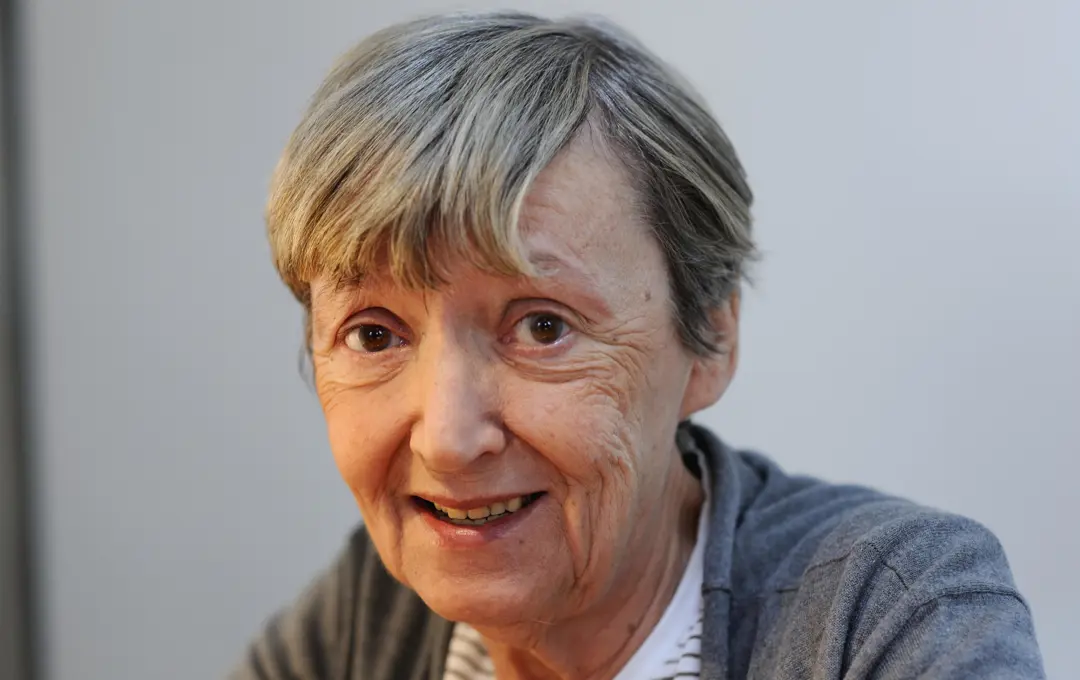A reliably bad child-rearing influence
Christine Nöstlinger (1936-2018) was an Austrian author who wrote more than a hundred books, for children of all ages. They range from imaginative stories to realistic descriptions of everyday life, and also include stories of a retrospective character. Her special tone of voice is humorous; free of illusions and sentimentality, unobtrusive and loving.
 Photo: Paul Schirnhofe
Photo: Paul Schirnhofe Quick facts
The jury’s motivation
Christine Nöstlinger is a reliably bad child-rearing influence of the same calibre as Astrid Lindgren. Her diversified and highly committed authorship is characterized by disrespectful humour, clear-sighted solemnity and inconspicuous warmth. She is a staunch supporter of children and those living on the margin of society.
Nöstlinger's books range from imaginative stories to realistic descriptions of everday life. They also include stories of a retrospective character, and reflect many children's current reality with little money, broken families and school bullies. Her special tone of voice is humorous; free of illusions and sentimentality; unobtrusive and loving. Nöstlinger's first book, Die feuerrote Friederike (Fiery Frederica) which she illustrated herself, was published in 1970.
Nöstlinger's masterpiece among imaginative stories is perhaps Konrad oder Das Kind aus der Konservenbüchse (Conrad: The Factory-Made Boy), that appeared in 1975. Her realistic descriptions of everday life include Ilse Janda, 14 (Girl Missing), 1974, Wetti und Babs, 1987, and Nagle einen Pudding an die Wand, 1990. Two books of a special character are Maikäfer, flieg! (Fly Away Home), 1973, and Zwei Wochen im Mai, 1981, describing nine-year-old Christel's experiences in Vienna during the last year of World War II.
Nöstlinger primarily wrote books for younger children, including two series, one about a boy, Franz (started in 1984) and the other about a girl, Mini (from 1992). Christine Nöstlinger was awarded with the Friedrich Boedecker Prize (1972), German Youth Literature Prize (1973), Hans Christian Andersen Medal from the IBBY (1984) and nearly thirty other awards and citations.
Christine Nöstlinger passed away on June 28, 2018, at age 81.
Oases of warmth, love and a sense of community
This text was written in 2003 by members of the award jury.
Christine Nöstlinger is an austrian author, born in Vienna on 13 October, 1936. Originally, she had plans of pursuing graphic arts and for a while she studied at the Academy of Applied Arts in Vienna. However, she terminated her studies, married and had two children. It was not until 1970 that she started writing children's books. She has also often worked as a journalist.
In Christine Nöstlinger's authorship, the child is always the centre of attention. She has unfailingly spoken on behalf of the youngest ones in books that reflect many children's current reality with little money, broken families and school bullies. Childhood is no idyll in her world, neither are children innocent angels.
Although Nöstlinger's gaze is free of illusions and sentimentality, it is humorous. Her independent and thinking children, who refuse to be treated as objects, are also wise, energetic and loyal. They frequently manage to clear up problems themselves supported by kind grandmothers, good friends and, not unusually, friends' parents. These parents sometimes understand other people's children better than their own. Small oases of warmth, love and a sense of community always exist in Nöstlinger's writing. Her solidarity also encompasses parents who do not really cope with their situation and deviant adults who have difficulties in behaving according to conventional norms.
Nöstlinger has a comprehensive authorship. Her books, which are published for children of all ages, may be divided into three main groups. The first one consists of imaginative stories where everyday reality is turned topsy-turvy and we suddenly find ourselves in a supernatural world. This category is permeated by a disrespectful humour in tune with Pippi Longstocking's anarchistic spirit. Nöstlinger's first book belongs here Die feuerrote Friederike (Fiery Frederica), 1970 (which she illustrated herself). The bullied heroine gets her Pippi-like red hair to glow and she even uses it to fly. Already here we encounter Nöstlinger's special mixture of humour, fantasy and social involvement.
The antiauthoritarian Wir pfeifen auf den Gurkenkönig (The Cucumber King), 1972, as well as the ingenious Der Zwerg im Kopf, 1989, also belong to the first category. In Der Zwerg im Kopf, a Nils Holgersson type pixie, with a pointed woolen hat, suddenly takes up residence in a schoolgirl's head and becomes her not entirely reliable speaking partner. Nöstlinger's masterpiece is perhaps Konrad oder Das Kind aus der Konservenbüchse (Conrad: The factory Made Boy), 1975, an hilarious story about a bohemian woman who gets a parcel containing an exemplary seven-year-old boy. Instead of simply poking fun at child-rearing, the uniformity of industrialism is also ridiculed. Das Leben der Tomanis, 1976, illustrated by Helme Heine, is another amusing book. Well-behaved children are not the only ones who start singing, jumping and somersaulting like wild tomanis. Their parents do as well, much to the horror of the neighbours.
The second category constitutes realistic descriptions of everday life. Even here, focus is on the child in the modern family with overworked and often quarrelling or single parents. However, the tone is more serious and the humour is subdued. Ilse Janda, 14 (Girl missing), 1974, is a book in Alice Miller's anti-child-rearing spirit where Ilse, the daughter of divorced parents, runs away because she is boxed on the ears so often. This type of story exists in Stundenplan (Four days in the life of Lisa), 1975, which depicts three days in the life of fourteen-year-old Annika. Here, the adults and their lack of understanding and love are sharply criticised. However, there is another type of adult in the background and even if the end is open, the tone is hopeful. Nöstlinger has continually alternated books of this type with her imaginative stories. Later examples include Wetti und Babs, 1987, and Nagle einen Pudding an die Wand, 1990.
A third and very special group consists of two books that have a retrospective character. Both have an autobiographical background. The first book, Maikäfer, flieg! Mein Vater, das Kriegsende. Cohn und ich (Fly away home), 1973, describes nine-year-old Christel's experiences in Vienna during the last year of World War II. After bombs destroyed their home, her parents fled to an empty house in a suburb where, after the Nazis' departure, they had to get on with invading Russians. In the other book, Zwei Wochen im Mai. Mein Vater, der Rudi, der Hansi und ich, 1981, Christel is twelve years old. Here the story deals with how the poor watchmaker's family tries to get on its feet amidst the piles of ruins. These two books belong to the zenith of Nöstlinger's authorship. The perspective is that of the child and the style is unobtrusive.
During the last decade, Nöstlinger has above all written books for younger children. Most of them have been published in two series in which one is about a boy, Franz (started in 1984) and the other is about a girl, Mini (from 1992). Even here one finds many instances of Nöstlinger's skill in telling riveting stories whilst raising matters that make the reader stop and think. One such example is Mini ist verliebt from 1999, where the reader, in contrast to eight-year-old Mini, soon understands that the boy she has fallen madly in love with is an unbearable showoff. Once again, we encounter Nöstlinger's special tone of voice: humorous, unsentimental, unobtrusive and loving.
Nöstlinger has been awarded Friedrich Boedecker Prize (1972), German Youth Literature Prize (1973), Hans Christian Andersen Medal from the IBBY (1984) as well as close to thirty other awards and citations.

Discover our laureates
The Astrid Lindgren Memorial Award is awarded to authors, illustrators and narrators, but also to people or organizations that work to promote reading.
Find out more about the laureates
Children have the right to great stories
To lose yourself in a story is to find yourself in the grip of an irresistible power. A power that provokes thought, unlocks language and allows the imagination to roam free. The Astrid Lindgren Memorial Award was created in 2002 by the Swedish government to promote every child’s right to great stories.
Find out more about the award